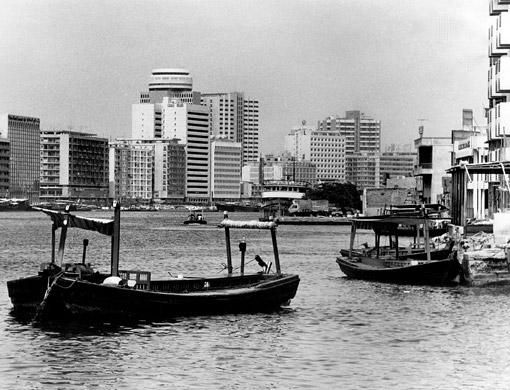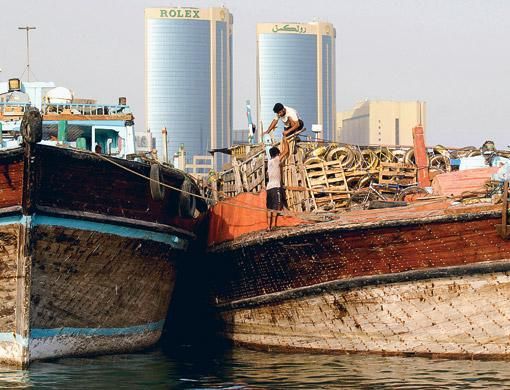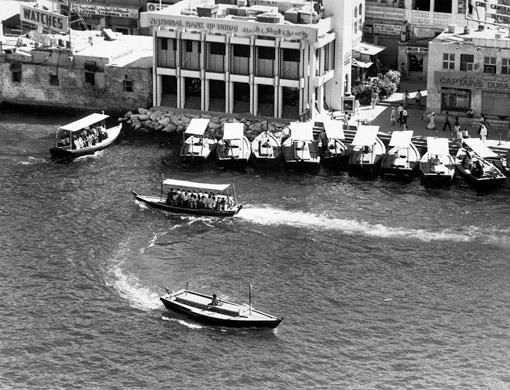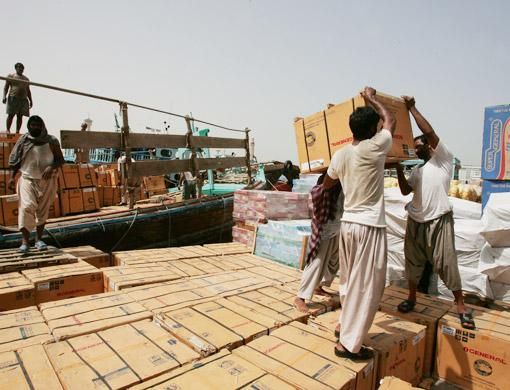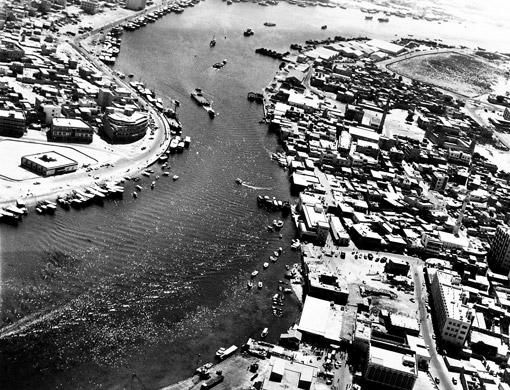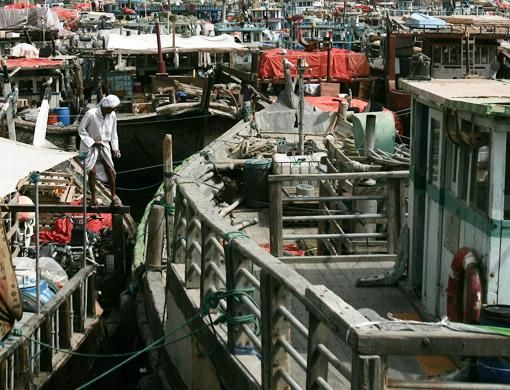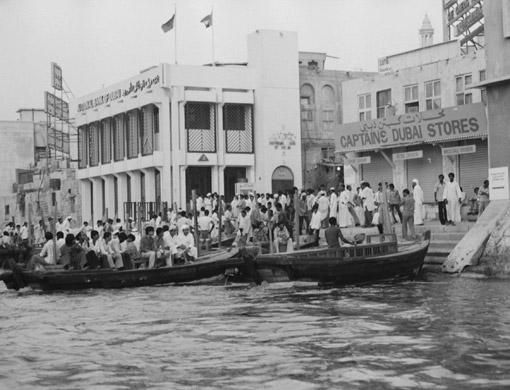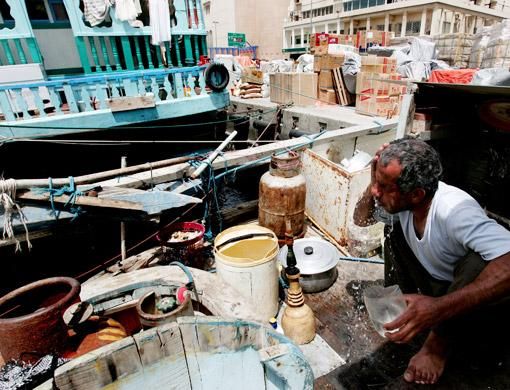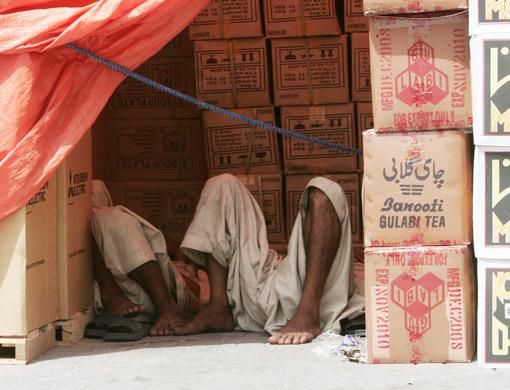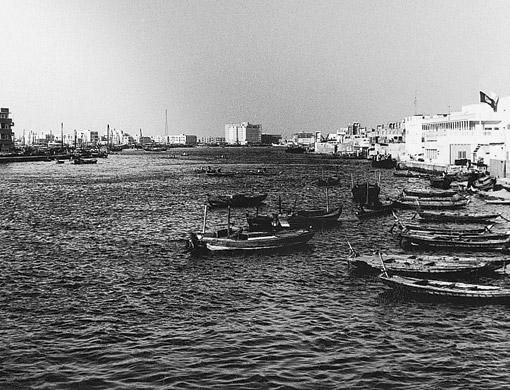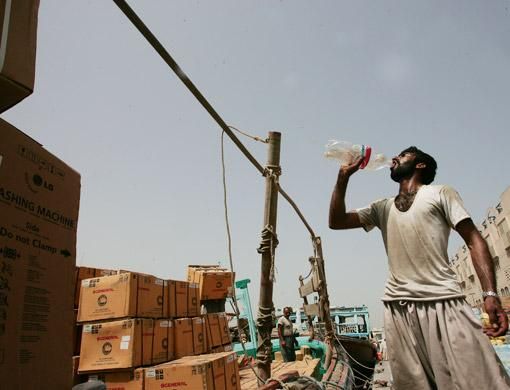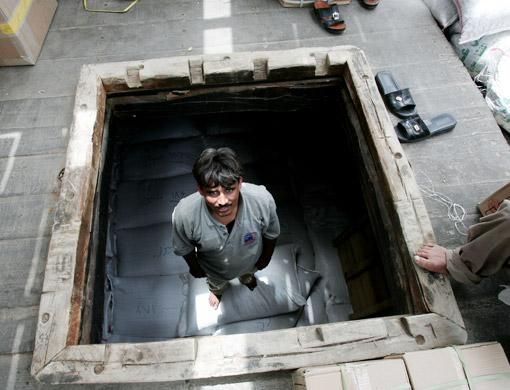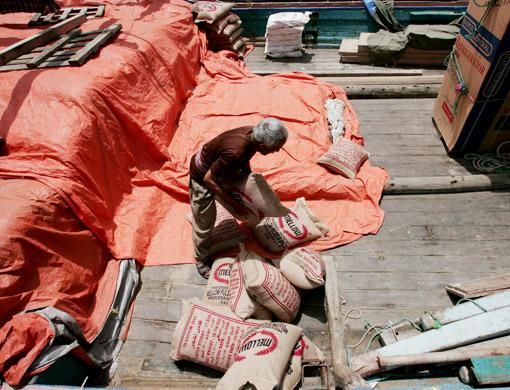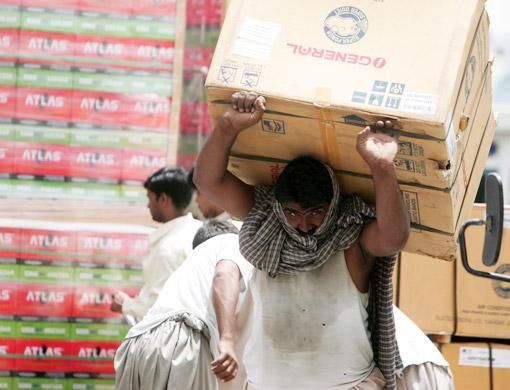The Dubai Creek, situated in the heart of Dubai and flowing between Bur Dubai and Deira, is where trade with the outside world began for the emirate more than a century ago. The growth of giant ports in the emirate has not diminished the Creek's importance, as it remains vital for regional traders, and is a vibrant reminder of Dubai's development into a commercial hub
Watch video on business by the Creek
Long before the World Trade Centre, Emirates Towers and the Business Bay, Dubai's business heart was the Creek.
The city's heritage as a harbour-based trading hub, dealing in pearls, fishing and the import-export business is well known. And many can still recall how the city came to life where the desert met the slow ebb of the Gulf's salt-water inlet.
"[The Creek] is the place where Dubai took place," says Jeremy Jones, senior research associate at the Oxford Centre for Islamic Studies.
Jones, who published Negotiating Change: the new politics of the Middle East in 2007, focused on the Creek in his book and explained that the traditional trading port not only launched Dubai as a commercial centre in the region, but set a precedent for the emirate's economic successes.
"One of the best anecdotes is that it was about 100 years ago that Dubai started offering tax breaks to pearl fishermen and I think this is a perfect example of how Dubai has been ahead of the game," said Jones.
Jones refers here to 1894, when foreign traders were permitted a full tax exemption.
And some of those still working in the businesses that grew up around the Creek fondly recall the trade boom that followed.
"Dubai used to mostly depend on exporting and re-exporting," explains Bhatia, who runs Tulsidas Lalchand General Trading Company. He sits at his desk in an office still close to the water in Bur Dubai. His family established the company in 1870 and his son Kishore is now the fourth generation to enter the business, which deals mostly in dry food goods.
The Creek Bhatia remembers is that of the 1960s, when the late Shaikh Rashid Bin Saeed Al Maktoum pioneered its development.
"Shaikh Rashid used to sign the papers," Bathia said. "He was a real businessman."
Before he became ruler, Shaikh Rashid recognised the importance of the Creek, and ordered an economic and strategic study in 1954 on deepening and widening it. The Dubai Creek Dredging Fund was established with £200,000 from a bank in Dubai and £400,000 loaned from Kuwait.
Dredging began in 1959 and silt that had built up on the Creek bed and made the waters too shallow for many larger boats was removed. Before the work began, boats carrying loads of 200 to 300 tonnes would anchor in the Creek, and upon completion, ships laden with 500 tonnes could dock there.
Nonetheless, it was still necessary for larger ships to wait outside the Creek to be met by smaller barges, dhows and tug boats that would transport cargo up the Creek and into Dubai.
Mushtaq Ahmad is an operations consultant who has been working for Kanoo, one of the biggest shipping agencies in the Middle East, since 1975. Established in 1890 in Bahrain, the family-owned company used Dubai's Creek to drop off and pick up goods before other ports were built.
"We brought the goods via small barges because at that time the Dubai Creek had a very shallow draught," remembers Ahmad.
The Creek played a very important role, agreed Bhatia and Ahmad, as it was the only area where many goods could be purchased.
"We were discharging and handing over the cargo," said Ahmad. "The cargo was coming from all over the world - the Far East, Africa, India and Pakistan. In those days nothing was produced in Dubai, it was all imported."
Bhatia can recall Dubai and its Creek moving from British rule to independence, and adopting the use of various currencies. He explained that visas were initially issued to his family by the British, who used to deal in Indian rupees. His family came from Karachi before the independence of Pakistan and a number of families from the same area worked as traders. "You could probably call it a clan," smiles Kishore.
On travelling recently to Hamburg, where Tulsidas buys sugar, he was shown a letter written by his great grandfather to the same company requesting sugar.
Bhatia recalls how the traders from India used to travel via boat to Bombay on business trips - a journey that would take eight days and include stop in cities such as Muscat and Karachi.
"In the old days not everyone could afford to take a propeller plane," his son explained.
Over the years, however, both the city and its traders have grown in scale and the companies that took root in the Creek moved on to take advantage of new port developments.
Port Rashid was opened in 1972 and Kanoo stopped using the Creek in about 1976, explained Ahmad, as most of their clients preferred to discharge their cargo directly rather than have it transferred up the Creek using smaller vessels.
The story of companies such as Kanoo, now a huge multinational, is closely entwined with that of Dubai's development into a major international trading hub.
Jebel Ali Port was founded in 1985 and much of the cargo coming into the Creek for re-export now passes through Port Rashid and Jebel Ali.
Tulsidas, too, has moved on from importing via the Creek as the company has grown over the years. The Bhatias used to import rice and sugar in quantities of five sacks at 100 kilograms each. "Now it's probably moved from five sacks to 50 container loads," said Kishore, explaining that they now supply major hypermarkets such as Carrefour.
"In the old days it was just groceries," said his father. "Now it is multinational retailers." Tulsidas now mainly uses Port Rashid and Jebel Ali to import their goods, he added. "Shaikh Rashid's dream to have a great port was a success."
Of course, most vessels and businesses have now moved from the Creek to Port Rashid and Jebel Ali. In 2007, exports from Dubai by sea topped 5.2 million tonnes, said Aqil Mohammad Hadi, director of the economic statistics department of Dubai Statistics Centre. Although precise statistics are hard to come by, he added that the Creek most likely represents a very small proportion of this.
Some, however, believe the future economic viability of the old port could lie in tourism. "The Creek could play a role in tourism," said Hadi. "It could hold more economic value in that way. Of course the government is doing this. There could be a source of attraction there, like in Sydney."
Aqil cited the examples of other cities that have turned their waterfronts into a place for visitors to enjoy. "If you go to Paris they use their waterways for transport, and in London they have the Thames," he said.
He believes there will always be a place for the Creek's dhows, as long as other small ports in the region remain. These old inlets are too small for the container ships that predominate in places such as Jebel Ali and they cannot cope with huge volumes of goods. But as long as smaller ports in Iran, Somalia and India exist, so will Dubai Creek.
"The merchants there [in the smaller ports] don't buy in too much bulk," said Aqil. "It is for retail sales, whereas in Jebel Ali they re-export it for wholesale. [The Creek] will not fade because some of the other ports are very small."
Blueprint: Path to Success
When speaking to a number of traders and shipping companies based in the region, there is a tendency to see the Creek as an anachronism that has been replaced by the likes of Jebel Ali Port and Port Rashid. However, while the modern-day equipment and massive scale of such facilities is indeed an upgrade, Jeremy Jones, senior research associate at the Oxford Centre for Islamic Studies, argues that the principles established in trading at the Creek remain.
The business practices that began at the Creek over a century ago haven't been forgotten in modern Dubai, he said, but rather that have been embraced and maintained as a blueprint for success in an era of globalisation.
In the early years of the development of Arab nationalism and the rise of figures such as Gamal Abdel Nasser in Egypt, Cairo and Beirut were considered the true Arab centres of the Middle East, he explained.
"It [Dubai] was thought of and written about as a little backwater," said Jones. "Move forward to where we are now and the whole phenomenon of globalisation has occurred. Far from being a backwater, Dubai was ahead of the curve."
The prominence of the Creek was what put Dubai in such a good position, said the academic, because of the economic diversity it brought as well as the tax breaks. "Dubai is more unusual than the surrounding emirates, not least because it developed a non-oil economy early on," said Jones.
Added to this was the development of a cosmopolitan centre in the Creek thanks to the presence of foreign traders, he said, a tradition which continues in Dubai to this day.
This cosmopolitan element is obviously still a central part of Dubai and something that is closely associated with globalisation, but Jones points out that this has been the case here for over 100 years, thanks to the Creek.
"It was a model based on looking after the foreigner," he said.
- With additional inputs from Nadia Saleem, Staff Reporter
TIMELINE
1833: Bani Yas tribe moves to Bur Dubai area, led by Maktoum bin Butti, founder of the Al-Maktoum dynasty. Previously a neighbouring tribal power, the eight hundred tribesmen moved to Dubai at a time when the creek's trade potential was already discovered.
1892: Sheikh Maktoum capitalized on the opportunity of the creek by signing an exclusive deal with the British
1894: Foreign traders were permitted a full tax exemption. Neighbouring Persians took advantage of this before traders from around the world joined in.
1903: The Sheikh convinced a major British steamship line to make Dubai a port of call, marking the beginning of a 25-year boom.
1929: Trade suffered due to The Great Depression and the discovery of artificial pearls, hampering the business of pearl diving that makes an integral part of Dubai's history.
1954: Sheikh Rashid ordered an economic study of the creek on deepening and widening it.
1961: Dubai Creek is dredged to allow easier access for wider and larger vessels.
Re-export potential of the port was realized due to the duty-free trade of Dubai. While the pearl trade diminished, gold replaced it with a conviction that led to the Dubai being coined as 'The City of Gold' for many years to come. The creek also thrived, as it became a port for gold smuggling.
1961 and 1963: initially, a canal of 4,000 feet long and six feet deep was dug and in the second stage, sheet piling of 1,200 feet length and 11,700 feet was laid on both sides of the creek. As a result, shipping movement increased and ships of a capacity of 500 tonnes were able to enter the creek.
1964: The creek sees the construction of Al Maktoum Bridge to permanently connect the both sides of the much wider creek.
While most of the trade shifted to Jebel Ali by this time, the creek remained the port for regional traders and the smaller facility of Port Saeed continued to exits along the creek.
1975: Al Shindhage tunnel opened with a total of four lanes, two in each direction. It remains the only underwater crossing of the creek to date.
1976: Al Garhoud Bridge is opened with three lanes in each direction.
1993: Dhow Wharfage was launched, providing berth for over 200 traditional trading dhows.
2003: The creek has eight wharfages, each capable of catering to 31 ships of capacity of up to 800 tonnes.
2007: The fourth crossing over the creek, Business Bay Bridge is opened with a total of 13 lanes, built at a cost of Dh800 million. A few months later, the Floating Bridge is opened with six lanes.
2008: Al Garhoud Bridge sees expansion to seven lanes in each direction, built at a cost of Dh415 million.
- By Nadia Saleem, Staff Reporter
Your comments
please leave the creek as it is, you can spend hours just gazing into the past, and admire those who sail the dhows.
Stephanie
Perth,Australia
Posted: April 30, 2009, 13:09
The creek is a phenomenon that gets to the very heart of Dubai. Before the oil and riches that came with it, Dubai was already an international city with mercantile flair. Great read!
Gonzologer
Dubai,UAE
Posted: April 30, 2009, 10:12


